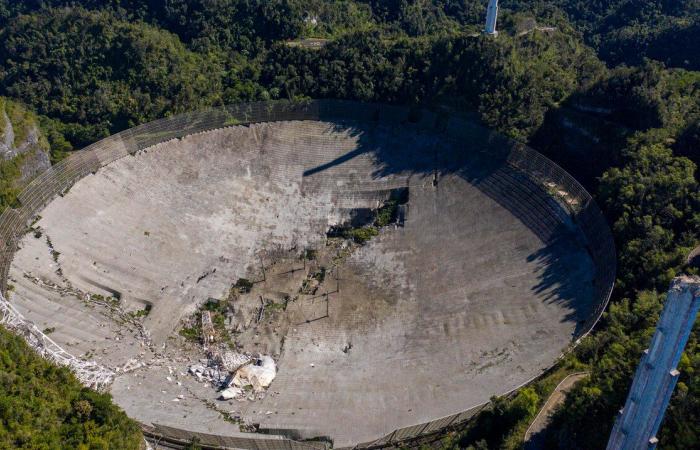Arecibo – Personnel from the Arecibo Observatory is in the process of inspecting and analyzing the damage caused by the collapse of the Gregorian dome on Tuesday morning and the platforms that allowed it to be located on specific points of the reflector plate.
However, the director of the observatory, Francisco Córdova, said that it is still too early to determine if the radio telescope can be rebuilt to return to its regular operation.
A third cable from tower 4 gave way and finally broke at 7:56 am, and the load on the remaining main and support cables turned out to be too great. The Gregorian dome and platforms fell onto the 305-meter reflector plate, one of the largest in the world, rendering the radio telescope inoperative.
“At this moment our staff is in the process of inspecting and analyzing the damage caused by the collapse of the Gregorian dome and its platforms. Part of the plate suffered significant damage, the tops of the three towers that supported the cables also collapsed, but none of our staff suffered damage, ”explained Córdova during a press conference held at the main entrance of the observatory.
The official added that the teaching center operated by the Ana G. Méndez University suffered slight damages due to the fall of the cables, but the other buildings and equipment are safe. He did not give an estimate of when it could reopen.
“In the inspection process, we will determine the stability of the rest of the structures and then begin the process of removal (of debris) and stabilization of the facility. We have already started a complete structural analysis of both the reflector and all the buildings, ”he said.
Córdova said that, for his part, he would love to see the radio telescope rebuilt, but, at the moment, the National Science Foundation (NSF) has not indicated whether, after the collapse, the planned partial demolition and reconstruction will take place.
The 12-meter dish, the LiDAR (laser distance measurement) facilities and the optical telescopes were not damaged and will remain operational, Córdova explained. “The rest of the observatory facilities will remain active,” he said.
Córdova stressed that they did everything possible to save the radio telescope, but the decision is in the hands of the NSF, which owns the observatory and the radio telescope.
“We are going to continue working to find a way to restore a similar capacity (of the radio telescope) or a higher capacity. We presented the NSF with various options (to try to avoid the collapse of the dome and platforms) when something could still be done, but they always stipulated that any work done would be done only if the safety of the workers could be guaranteed and contractors. There were a number of options that, in their time, could have been executed if decisions had been made quickly enough. But with the passage of time, the structural degradation continued and became a safety risk for the personnel, ”Cordova highlighted.
The observatory director explained that among the options presented to the NSF were the removal of nearly 46,000 pounds of counterweights located on the azimuth platform (to balance the structure) and reducing the stress on the rear cables that would have caused the towers moved 18 inches inward and would have reduced the load on the main cables by four to five percent.
Córdova denied that budget cuts played a role in the collapse of the radio telescope and stressed that the facilities always received the required maintenance.
“The total funds allocated after Hurricane Maria were $ 14.3 million. Of that total, they gave us $ 2 million that was used to carry out repairs at the facility and to prepare for the hurricane season. We also created a full proposal for the utilization of the remaining $ 12 million and it was approved in 2019. The University of Central Florida received and used another $ 2 million for planning, contractor quotes and to purchase generators, but the remaining $ 10 million is still available. has the NSF “
The official said he has had conversations with the elected mayor of Arecibo, Carlos “Tito” Ramírez, and with staff from the office of Governor Wanda Vázquez Garced.
“We are going to fix the minimal damage that the learning center suffered and we will continue to operate the optical, LiDAR and 12-meter dish facilities. Here we have petabytes of information that still needs to be analyzed for publication and research. Operations will continue apart from the radio telescope ”, Cordova pointed out.
These were the details of the news The decision to rebuild the Arecibo radio telescope will rest with the National Science Foundation for this day. We hope that we have succeeded by giving you the full details and information. To follow all our news, you can subscribe to the alerts system or to one of our different systems to provide you with all that is new.
It is also worth noting that the original news has been published and is available at en24news and the editorial team at AlKhaleej Today has confirmed it and it has been modified, and it may have been completely transferred or quoted from it and you can read and follow this news from its main source.

